Finishing Services that Add to or Alter the Component Surface
There are a variety of surface finishing techniques that add to or alter the surface layer of metal for a precision turned component. These finishing techniques can be utilized for aesthetic reasons, to protect the part from environmental factors or to improve the function of the part.
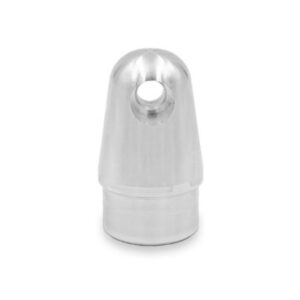
Most finishing techniques can be applied to precision machined components that have been produced on CNC Swiss and CNC turning equipment. However, the material, part design and final requirements will need to be evaluated with our engineering and quality teams to ensure that the best combination of techniques are being considered.
Here is a quick overview of the some of the most common types of finishing services:
Bead Blast – bead blasting the surface of a precision machined component creates a uniform matte (satin) finish and removes the tool marks that are often visible from the machining process. This is often used when the component will be visible. As the name suggests, the component is blasted with small beads from a pressured gun. The process removes some material and leaves a smooth surface.
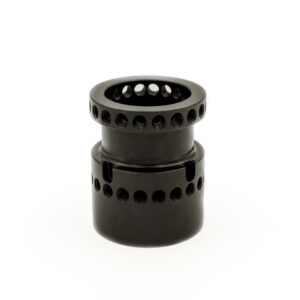
Black Oxide – Black oxide is a conversion coating which turns the surface of the precision machined component black. It is used for mild corrosion resistance, to minimize light reflection and often for appearance. Many parts for the firearms industry require a black oxide finish to reduce light reflection. More on this process can be found in our blog post on Black Oxide.
Burnishing – Burnishing is a forming process that alters the surface finish, size or surface hardness of a precision machined component and creates a mirror finish. It can be used to improve corrosion resistance, to eliminate surface porosity, reduce fatigue failure and reduce surface visual defects. In the process, a hardened and coated ball or roller are run over the surface of the component to deform (or shape) it to the specified requirement.
Case Hardening –
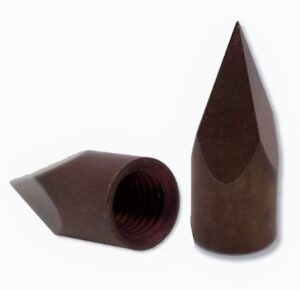 Case hardening is a process to harden the surface of a metal component, while leaving the interior (core) metal at its original, softer state. This allows the core of the component to absorb stresses, but the outer surface to have improved wear resistance. There are several different types of case hardening processes depending on the material and requirements. The most common types of case hardening for precision machined components include flame hardening, carburizing and nitriding. Flame hardening is the most common and heats the component (or bar stock) rapidly to a specified temperature, and then cools it rapidly, creating a layer of martensite on the surface. Carburizing and Nitriding are explained below.
Case hardening is a process to harden the surface of a metal component, while leaving the interior (core) metal at its original, softer state. This allows the core of the component to absorb stresses, but the outer surface to have improved wear resistance. There are several different types of case hardening processes depending on the material and requirements. The most common types of case hardening for precision machined components include flame hardening, carburizing and nitriding. Flame hardening is the most common and heats the component (or bar stock) rapidly to a specified temperature, and then cools it rapidly, creating a layer of martensite on the surface. Carburizing and Nitriding are explained below.
Diffusion processes –
- Carburizing: a type of case hardening process where the steel component is put in a carbon rich vacuum tank that elevates the temperature for a certain amount of time before quenching the part so that carbon is locked into the structure creating a hardened surface.
- Nitriding: in this process, the steel part is heated to a high level in a tank with ammonia gas for a specified amount of time. Nitrides form on the surface, creating a hardened surface. No quenching is needed with this process. Nitriding causes the least amount of distortion, but also requires the steel to have chromium, molybdenum and aluminum in its makeup.
Electroless (chemical) Plating – In this process, the metal coating on the machined component is achieved in a chemical bath that includes a catalyst (in contract to the electroplating process which uses an electrical current to plate the component). Plating provides improved surface finishes, as well as improved wear and corrosion resistance. The main advantage of electroless plating is that it creates an even layer of plating, regardless of the geometry of the part. Electroless nickel plating is a common type of plating specified for precision machined components.
Electroplating – is a process used to coat a machined component with a layer of metal, using an electrical current. Widely used to improve surface qualities, it offers improved appearance, corrosion and abrasion resistance, lubricity, electrical conductivity and reflectivity, depending on the substrate and the plating material choice.
There are two general ways of electroplating machined components, depending on the size and geometry of the part: barrel plating (where the parts are put in a rotating barrel filled with the chemical bath) and rack plating (where the parts are attached to a metal rack and the rack is then dipped in the chemical bath). Barrel plating is used for small parts with simple geometries, and rack plating is used for larger parts with complex geometries.
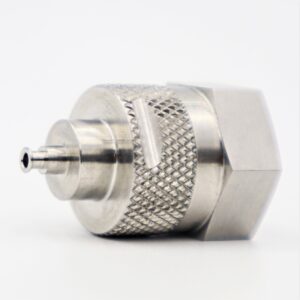
Knurling –
is a process to add a series of indentations on a machined part so it is easier to handle (doesn’t slip in someone’s grip). It is often used on fasteners where they will need to be screwed into something – the knurled surface makes it easier to grab the part for turning. Knurling can be done on a CNC Swiss part during the turning process or added to a part after it has been machined.
Passivating –
is a conversion process which changes the surface layer of the component. Parts are dipped in a chemical bath which changes (converts) the chemical composition of the surface. The terms passivation refers to the fact that the process makes the material more passive (less likely to be affected by the environment). The coating protects the substrate material.
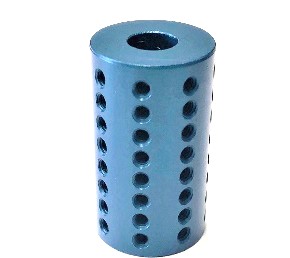
- Anodizing – is a type of passivation process that is used to increase the thickness of the oxide layer on the surface of precision machined components, which increases the part’s resistance to corrosion and wear and reduces the galling on threaded components. Used often on aluminum parts. Anodizing produces a nonconductive surface finish.
- Chromate Conversion uses a particular type of solution – in the past this was mostly hexavalent, but many companies are moving to trivalent (blue and yellow finishes which meet the EU initiatives and RoHS standards). Chromate conversion produced an electrically conductive surface finish.
Thread Rolling –
is a forming process that produces a thread on a precision machined component. While many threads can be produced during the turning process on a CNC Swiss machine, some materials (like titanium) are best thread rolled after the blanks are machined. Many aerospace threaded fasteners use threads rolled after machining. In this process a die that is shaped with the threads is pressed against the machined blank, and physically moves (displaces) the material to form the threads (as opposed to the making threads on a CNC Swiss lathe, where the thread is formed by removing material from the bar stock). Just from a visual comparison, it is difficult to tell the difference between threads that are thread rolled or threads that are machined.
Finishing Services that Remove or Reshape the Component Surface
There are several surface finishing techniques that “remove or reshape the surface layer” of a precision machined component. These finishing techniques can be applied to a wide variety of materials, to both CNC Swiss and CNC turned components, and provide increased durability, tighter tolerances, better aesthetics and improved functionality for many applications.
Here is a list of some of the most common types of finishing services that “remove of reshape the surface layer” of turned component:
Electropolish –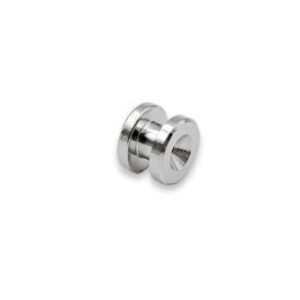
is a polishing process that uses an electrical current to remove material from the surface of a machine component. This process improves the surface finish by leveling out the micro-peaks and valleys on the surface layer of metal created during the machining process. It is the opposite of electroplating, in which a current is used to add material to the surface of a machined component to level out the surface layer.
Grinding –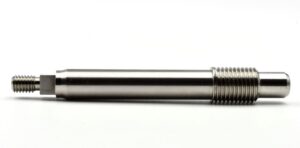
is a process that uses an abrasive grinding wheel to remove material from the surface of the precision turned component. This improves the surface finish and provides extremely accurate dimensions for a wide variety of applications. Depending on the geometry of the turned component, centerless or centered grinding may be used to complete the finishing process. Grinding can be done on the OD (outside diameter), ID (inside diameter) and a variety of types of features on the components (ie: holes, slots and flats).
- Honing – is a subset of grinding, used on the ID of a precision machined component. It is more like a polishing process than a true grinding process. The honing process uses a rotating stone (hone) with a fine abrasive to remove/polish a fine layer of the surface material.
- Lapping – is also a subset of grinding, used on the OD of a precision turned component to improve the surface finish and provide tighter dimensional controls. In this process, the abrasive material is in a paste form applied to a lap plate, and the component is passed against the plate to remove/polish the surface layer.
Laser engraving –
is a process that uses a laser to create an image (usually letters, numbers or a logo) on the surface a precision machined component. The laser beam vaporizes the metal. This process is used when the font or shape required can not be created during the turning (or milling) process.
Pickling –
is a chemical treatment that removes material from the surface layer of the metal. For precision machined components, it is most often used to clean (remove) the surface scale created during the heat treatment process. Components are dipped in an acid bath that dissolves the oxide scale from the surface level of the part.
Tumbling –
Barrel tumbling is a process that uses various sizes and types of tumbling media in a rotating barrel to rub against the surface layer of the components. This removes excess material, burrs, can harden the surface, polish out machining marks, brighten and burnish the parts. The size and type of media used will vary depending on the material of the component, its geometry (size and features) and final requirements. Tumbling media can be made of metals, ceramics and plastics and come in a wide variety of sizes and shapes.
Vibratory Finishing –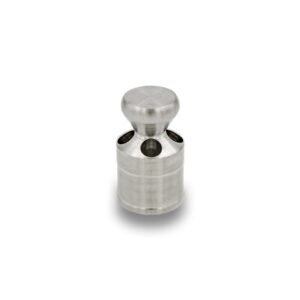
Similar to tumbling, turned components are put into a tub like machine that has vibratory media in it. The tub is vibrated so the media jostles against the part to remove surface marks, burrs and result in an improved finish. Vibratory finishing is used more often than barrel tumbling for turned components due to the complexity of features and tight tolerances of the parts.
Summary:
Pioneer Service has been producing precision turned pins, shafts, fasteners, poppets, rods, bolts, washers, screws, clips, ferrules, stems, o-rings, nuts, knobs, studs, buttons, and a wide range of other complex and tight tolerance components for their list of global manufacturing clients for over 30 years. Many of these components go into medical, aerospace, automotive, and industrial applications with unique finishing requirements.
Pioneer Service has developed an extensive network of qualified vendors for projects with specific finishing requirements. We have produced a wide variety of custom turned components for clients in the Aerospace, Medical, Hydraulics, Oil and Gas, Test and Measurement, and Industrial Markets with unique surface finish specifications. We are AS9100D and ISO 9001:2105 certified. Custom washers, bolts, poppets, fasteners, screws, spacers, flanges, rods, buttons, studs, rivets, knobs, nozzle tips, collars, pistons, inserts, electrodes, shafts, bushings, caps, sleeves, ferrules, stems, o rings, rods, nuts and pins are some of the many types of parts we make for our customers.
To learn more about our AS9100 and ISO9001:2015 capabilities for turning precision components, contact Pioneer Service today.



